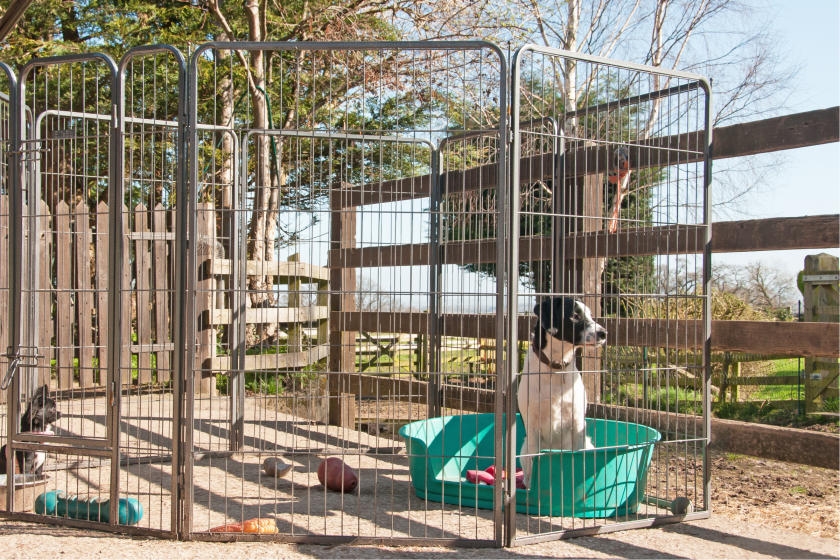You can’t watch your dog every second. You love Fido, but let’s face it — many pets often need some alternative to round-the-clock supervision. Building a dog kennel might be just the job to offer security and assistance for your dog when you’re not around or available to watch him. Kennels contain dogs in a controlled area, whether inside or out, keeping them safe and out of trouble.
Building an Outdoor Dog Kennel
Step 1: Determine Location and Size
Start by choosing the location where you will be building a dog kennel. Size up the amount of space you have to work with and whether the kennel will work in that location. The kennel’s size needs to give your dog adequate room to move around in. Larger dogs, of course, need more space than smaller breeds.
Helpful Tips
If your dog currently has a dog house outdoors, be sure you allow room for it when figuring out the dimensions of the kennel.
If you don’t plan on adding a roof to the kennel, make sure the walls will be high enough that your dog cannot jump out.
If you will be building a dog kennel without a kit, use a tape measure to determine the dimensions of your kennel and then mark them out either with a chalk line or with stakes and twine. If you feel you don’t have the time to take on the project, your local True Value hardware store has dog kennels available for purchase that feature rust-resistant, galvanized steel tubing and chain link fencing. Many models require only a hammer and an adjustable wrench. These kennels also don’t require digging holes or laying concrete. Follow the manufacturer’s instructions carefully.
Step 2: Prepare Area
Begin preparing the area for the kennel by creating holes for the fence posts on which to install your chain-link fence. First determine the end on which you will install your fence gate or door. Then starting with a corner, use a post-hole digger to dig 12″ to 24″ holes twice as wide as the diameter of your fence posts at equidistant intervals along the length of each side. Your fence support posts will be placed in each hole. See Step 4 for further fencing instructions.
Safety Alert!
Before digging, contact your local utility companies to see if there are any underground power or gas lines nearby.
Helpful Tip
Check local municipal codes to ensure that your kennel is allowed under current regulations.
If your dog is a digger, you may want to install a permanent or semi-permanent floor to keep him from being able to dig under and out of the kennel. This can be remedied by laying down a piece of particle board or similar piece of wood, rated for outdoor use (so that it lasts when left out in the elements). Simply cut the wood to fit the dimensions of your kennel with a circular saw.
A more permanent solution is to build a dog kennel using a concrete kennel floor. Use a level-headed rake, or a garden tiller, to remove the grass and loosen the topsoil in the staked off area. Dig out the dirt in the area to a depth of about 3″ to 4″. Then tamp down the soil with a tamper. Next, you’ll be pouring concrete for the floor. You’ll have to build a “form” to mold the poured concrete into the right shape. Use pieces of 2″ x 6″ lumber to create the form, cutting to fit when necessary, using a circular saw. Fit the pieces of lumber on their edges along the border of your dug out area until you have “walls” around the run location. Fasten the pieces together using wood screws and a power drill. See the steps for pouring concrete in the next step.
Step 3: Lay Down the Floor
Spray the dug-out area with water from a garden hose so that it is soaked. This will keep your concrete from drying out too quickly when you’re pouring. Fill a wheelbarrow with concrete mix and water as directed by the manufacturer’s instructions located on the package. Pour the concrete from the wheelbarrow into the dug-out area, spreading it out into corners and edges with a shovel. Fill the area this way until the concrete is just above the sides of the form. Even it out and level it using a board as a “float,” running it across the top of the slab until it’s even with the sides of the form and flat. When the surface has been smoothed, let it set for the amount of time recommended by the manufacturer.
Safety Alert!
Be sure to wear safety glasses, gloves and protective clothing while working with concrete, because it may irritate your eyes and skin.
Step 4: Install Fencing
Fill the bottom of each of the holes you dug in Step 2 with about 2″ of gravel or crushed stone for drainage. Mix dry concrete and water in a wheelbarrow as directed by the manufacturer. Place one of the support posts into a hole and hold it so it’s centered in the hole. It helps to have someone hold the post steady as you shovel the prepared concrete mix into the hole. Use a level to make sure the post is straight. Level the concrete off with a shovel, just a few inches on top of the hole. Slope the concrete around the base of the post to allow for water runoff. To reduce any air pockets, poke a small stick into the concrete in a few random places.
Helpful Tip
If you don’t have another person to assist you, use two long pieces of rope or wire to steady the post as you pour. Tie the rope or wire around the center of the post and use two stakes to secure the post in an upright position.
Repeat the process with each of the support posts. Let the concrete dry and set for the time recommended by the manufacturer.
The next step in building a dog kennel is to attach the fencing to the posts. Begin at one corner, attaching the fencing at the top and bottom of the post with fence ties and pliers. You must bend the ties with the pliers so that they go through a link in the fence and then attach to the post. Follow any instructions included with your fence hardware. Unroll and stretch the fencing to the next post and fasten it to the post with fence ties and pliers. Be sure that you’re stretching the fence as tight as you can as you move along. Have someone help you if needed. Repeat the process until you’ve installed each side of your new dog kennel’s fence.
Safety Alert!
When stretching the fencing, wear heavy work gloves to protect your hands and make the job easier.
Attach the fence gate to the opening you left, by fastening the gate hinges and latch as directed by the manufacturer.
Helpful Tip
After gate installation, check to be sure that the gate doesn’t leave a gap on the bottom or either of the sides through which your dog can slip through.
Step 5: Add a Roof
To keep your dog in the shade, cover the top of your kennel with tarps. Building a dog kennel roof using tarps instead of a permanent roof allows you the option of removing it when desired. Fasten the tarps to the top of the fence with plastic cable ties. These are easily replaced if you need to remove the tarp. It’s unlikely that you’ll need or want to cover/re-cover the dog kennel often.
Building an Indoor Dog Kennel
Indoor kenneling can be accomplished with training crates or portable traveling kennels. Dogs are instinctively hard-wired to feel comfortable in small spaces in which they feel safe and secure, like they are in a “den.” Dogs, especially puppies, that are introduced to a training crate will quickly grow accustomed to the crate and learn that it’s his “space” to go to for privacy, rest and even meals. Crates are effective training tools for dogs, used for housebreaking and teaching them boundaries. As the dog is comfortable in the crate, leaving him there while you are away — so that he can’t get into any kind of trouble — is no problem. You can train your dog to get used to the kennel by putting its bedding, treats or favorite toys into the kennel and then coax him in with treats and positive reinforcement. Some older dogs may be hard to convince. Be patient. Forcing them to go in will only make them associate the kennel with anxiety.
Your local True Value hardware store has a number of training dog crate models available in different sizes so that they are a perfect fit for your pet. Ask an expert there which model best suits your needs.
Another option for building a dog kennel indoors includes turning an unused room in your home into a “kennel” if you have the space. Or you can turn your garage, a utility room or laundry room into a kennel space during the day when you’re away. These types of spaces are ideal for placement of a training crate. If not using a crate, pet gates, similar to child safety gates, can be installed at the doorways of rooms to keep dogs securely confined to the space. When installing the gate, follow all manufacturer instructions carefully.
Helpful Tips
Be sure that the gate or barrier you use is high enough that your dog can’t jump over it and wreak havoc while you’re out.
Hinged gates are more convenient for keeping your dog isolated in one area. You won’t have to step over or remove it every time you need to go in and out of the area.
Don’t use a carpeted room for your kennel unless your dog has a proven record of leaving carpets alone. Or, you can lay down rubber mats to cover the carpet and keep it soil- and damage-free.
Safety Alert!
Make sure all items in a room that can harm your dog, such as electrical cords, detergents, chemical cleaners, etc. are stowed away out of the dog’s reach.
Congratulations! Now that you know how to build a dog kennel, you can keep man’s best friend secure and safe.
Project Shopping List
Here’s what you’ll need to complete this project successfully.
- Hammer
- Adjustable wrench
- Tape measure
- Twine
- Stakes
- Manufactured kennel (optional)
- Post hole digger
- Particle board
- Circular saw
- Level-head rake
- Garden tiller
- Tamper
- 2″ x 6″ lumber
- Wood screws
- Power drill
- Garden hose
- Wheelbarrow
- Concrete mix
- Shovel
- Safety glasses
- Safety work gloves
- Protective clothing
- Gravel or crushed stone
- Fence posts
- Fence gate
- Rope or wire
- Fence ties
- Fences
- Pliers
- Tarp
- Plastic cable ties (if needed)
- Training crate or portable traveling kennel
- Pet gate













